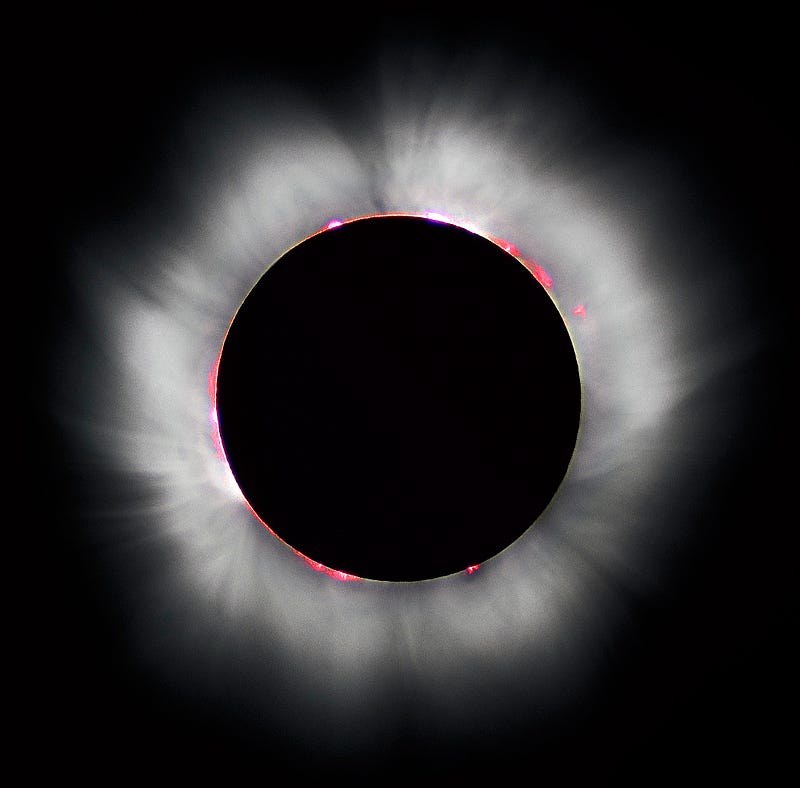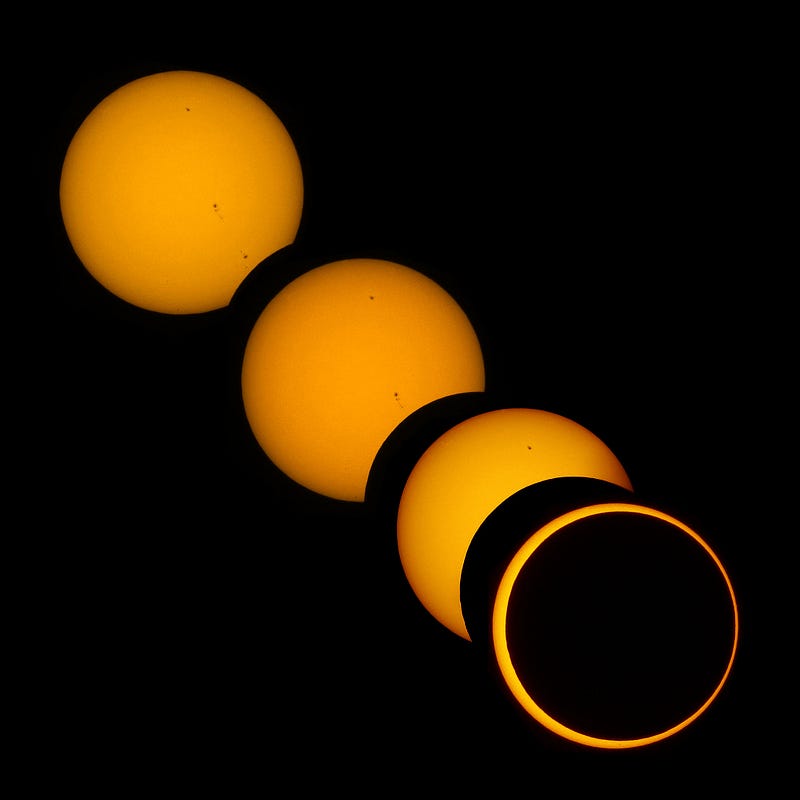Exploring Solar Eclipses: Origins, Safety, and Viewing Tips
Written on
Understanding Solar Eclipses
A solar eclipse occurs when the Moon obscures the Sun, creating a spectacular event that captivates amateur astronomers and enthusiasts alike. Historically, this occurrence sparked fear and was interpreted as a divine sign by ancient priests. Today, it serves as a thrilling spectacle that anyone can safely enjoy with proper precautions.

What Exactly Is a Solar Eclipse?
A solar eclipse is defined as the moment when the Moon blocks part or all of the Sun's disk. This celestial event occurs when the Moon passes through the shadow of the Earth or when the Earth casts its shadow on the Moon, leading to phenomena like lunar eclipses. These events happen when the Moon aligns closely with one of the nodes in its orbit during a new moon (solar eclipse) or a full moon (lunar eclipse).
Types of Solar Eclipses
Solar eclipses can be categorized as either partial or total. A total solar eclipse happens when the Moon completely covers the Sun, while an annular eclipse, or "ring of fire," occurs when the Moon is too far from Earth to completely obscure the Sun, leaving a bright halo visible. A solar eclipse typically goes unnoticed until at least 80% of the Sun is covered, after which observers may feel a distinct drop in temperature.
The most dramatic of these is the total eclipse, where nearly the entire solar disk is obscured, resulting in a significant temperature drop at the observation site.

Future of Total Solar Eclipses
Interestingly, total solar eclipses will eventually cease to occur. The Moon is drifting away from Earth at a rate of approximately four centimeters annually. In about 600 million years, this gradual movement will mean that the Moon's apparent size will no longer be sufficient to fully obscure the Sun, leading to only partial and annular eclipses visible from Earth.
Safe Viewing Practices
Safety is paramount when observing a solar eclipse. Never look directly at the Sun without proper eye protection, as even tinted glasses won't suffice. For those wishing to observe the eclipse safely, many planetariums and science centers organize professional viewing events. Those opting for personal observation can equip their telescopes with specialized solar filters available at optical retailers.
A simple yet effective way to view the eclipse is to project an image of the Sun onto a white surface using binoculars or a small telescope.
Upcoming Solar Eclipses
Solar eclipses are dependent on the precise alignment of the Earth, Moon, and Sun. This complex interaction means they do not occur regularly. The next significant solar eclipse will take place on October 25, 2022, peaking at 12:17 PM with 34% of the solar disk covered. Notably, an annular eclipse occurred on January 15, 2010, lasting over 11 minutes in some regions, with the best views from the Indian Ocean, parts of Africa, and Asia.

Historical Milestones in Solar Observations
Throughout history, significant dates highlight our understanding of solar phenomena:
- 3340 BC: Earliest known depiction of a solar eclipse in Loughcrew, Ireland.
- 467 BC: Anaxagoras first describes sunspots in Greece.
- 968 AD: The solar corona is observed during an eclipse in Constantinople.
- 1611 AD: Galileo and others begin systematic observations of sunspots.
- 1859 AD: Richard Harrington records a major solar flare in England.
- 1904 AD: Installation of the Snow Solar Telescope in the USA, still operational today.
- 1959 AD: The USSR's Luna 1 probe becomes the first to detect solar wind.
- 1973 AD: The Apollo Telescope Mount photographs solar explosions.
- 1995 AD: The SOHO probe starts continuous solar monitoring.
The first video titled "2024 Total Solar Eclipse: Through the Eyes of NASA" provides an official broadcast that captures the essence of this extraordinary event.
The second video, "How to Safely View Solar Eclipse if You Don't Have Eclipse Glasses," offers practical tips for safely observing solar eclipses without specialized eyewear.
Conclusion
Understanding solar eclipses enriches our appreciation for these celestial events. Embracing safety measures ensures a memorable experience while observing the wonders of our universe. Your support in recognizing this effort is appreciated; feel free to leave a tip or follow for more insights!